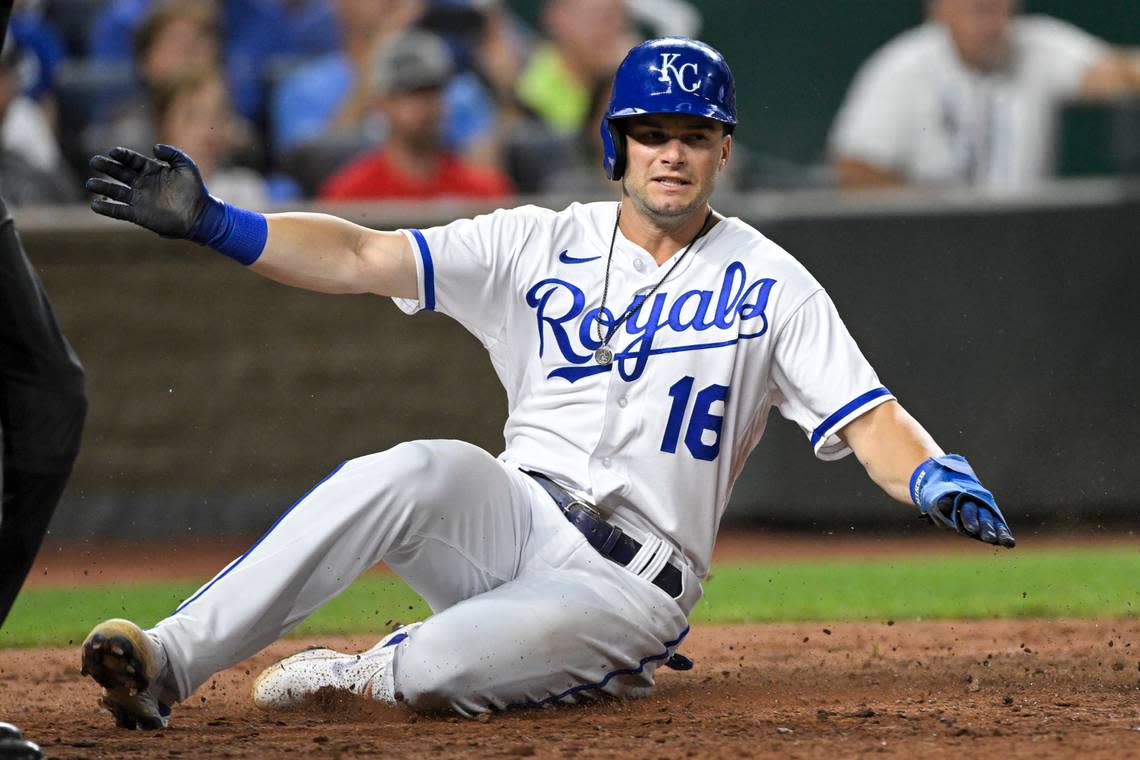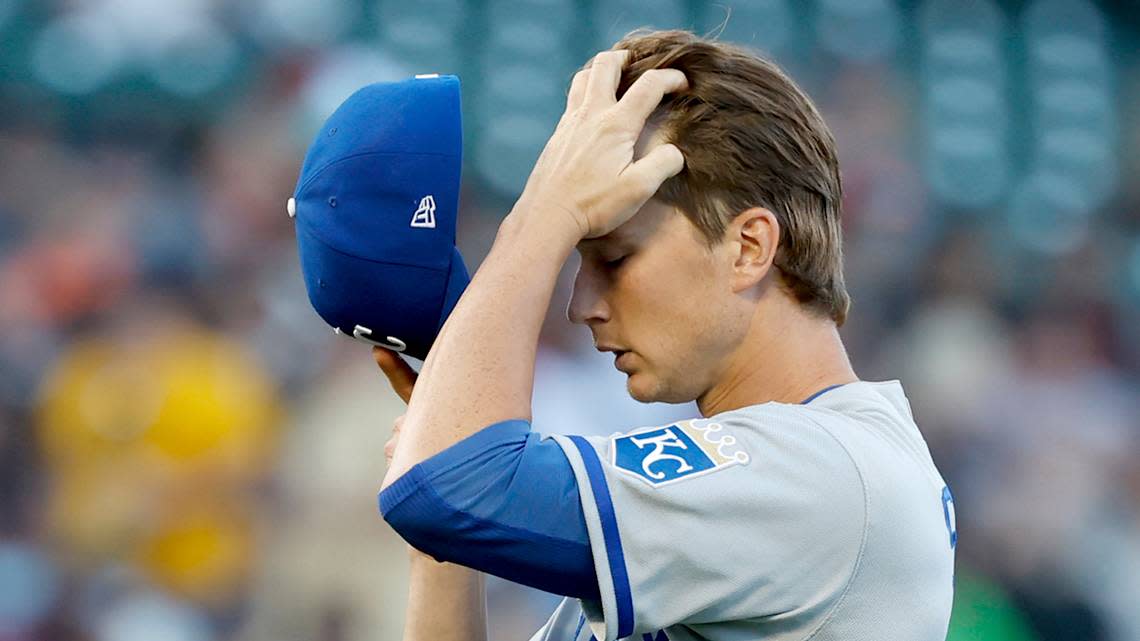Shaping Kansas City Royals’ future will be a focal point for the rest of the season
The real big-picture question surrounding the Kansas City Royals isn’t which players will go at the trade deadline, though that’s certainly an intriguing question.
It’s actually: How is their youth best served?
At the MLB All-Star break, the Royals are 20 games below .500 with a record of 36-56, which put them in last place in the AL Central Division, a game behind the Detroit Tigers (37-55).
They went 19-21 from the start of June through their last homestand, and they’d won three of the last four series with the roster that they’ll put out on the field in their first series post All-Star break (the eight players who were called up for the Toronto trip to replace unvaccinated players have returned to the minors).
That roster has featured a large chunk of young homegrown talent still trying to establish itself in the big leagues, led by shortstop Bobby Witt Jr. and including catcher MJ Melendez, first baseman Vinnie Pasquantino, third baseman Emmanuel Rivera, outfielders Kyle Isbel and Edward Olivares as well as pitchers Brady Singer, Kris Bubic, Jackson Kowar, Daniel Lynch (currently on the IL), Dylan Coleman, Jose Cuas, Wyatt Mills.
Each of those players remains in that two-to-three year window that Royals president of baseball operations Dayton Moore has often cited as the time it takes for a player to fully become a big-league player.
Royals infielder Nicky Lopez, barely outside of that group himself, recently described having such a young team as “special,” and “a glimpse of the future.”
“You try to help these guys out as much as possible,” Lopez said. “But it’s good that they’re getting their bruises right now and riding that roller coaster, so to speak, early because it’s only going to set them up for future success.
“Why not get it over with when you’re 21, 22 years old as opposed to when you’re 25, 26, 27 years old.”
Last weekend’s series in Toronto proved there’s certainly another wave of your players waiting in the minors for their chance.
But would the current core benefit more from another influx of youngsters learning on the job and just going all in on youth, or is there something to be gained from the more experienced Royals during this transition period?

Benintendi’s benefited from veterans
Royals All-Star left fielder Andrew Benintendi broke into the majors with the Boston Red Sox on a youth-filled club of homegrown players.
When he made his debut in 2016, shortstop Xander Bogaerts, outfielders Mookie Betts and Jackie Bradley Jr., catcher Christian Vazquez and relief pitcher Matt Barnes were still in the early stages of their big-league careers. Pitcher Eduardo Rodriguez, who began his career in the Baltimore Orioles farm system, was also in that group.
The next season, third baseman Rafael Devers joined. In 2018, that group won a World Series title together.
Speaking to The Star prior to the All-Star break, Benintendi pointed to the influence of the veteran on that club as having played a crucial part in the success of the Red Sox young stars and the team as a whole.
The fingerprints of David Ortiz and Hanley Ramirez were certainly felt on those early clubs in much the same way Chris Sale and Rick Porcello helped shape and drive the club following Ortiz’s retirement in 2016.
“I think it’s super important to have guys that have been around and know how it goes and understand how to be in a clubhouse and treat the other guys and show them how to do it,” Benintendi said. “Because there is a way to do it and a way not to do it. A way of them keeping you in check but also being tough love. That’s how it was over there, but in a good way — never in a bad way.
“I think the veteran leadership over there is what made the younger guys pull more talent out of them. Maybe I’m speaking just from my experience, but I think that pushed me more when I had an older guy encouraging me but also pushing me to do better and be better. I think that’s what made that group, and me personally, play better and win more games.”
The incubator that was the Red Sox clubhouse brought forth a former MVP, six-time All-Star, five-time Gold Glove winner, four-time Silver Slugger winner and a batting title champion in Betts, four-time All-Star in Bogaerts, a Gold Glove winner and ALCS MVP in Bradley, two-time All-Star and a Silver Slugger winner in Devers, an All-Star in Barnes and a Gold Glove winner and All-Star in Benintendi.
“I think, for example, that year we won 108 games,” Benintendi said. “If we don’t have as many established guys who’d been around for a while, that could have been five-to-seven games less.”
“Whether it be a pitcher, an older guy, telling a younger pitcher this is how you settle down if you get in a rut. Even little things like that, that can win you a game. That adds up over the course of the season.”
Benintendi admitted he didn’t fully appreciate the difference made by those veterans until looking back in hindsight.
His experience isn’t necessarily universal. And some of those rosters were clearly loaded with an extraordinary level of talent.
But it does at least provide some perspective as far as what experienced veteran players might do to enhance a young core of talented players still finding their way in the majors.

Where they rank
OFFENSE
Runs per game: 3.9 (26th)
Batting average: .244 (14th)
OBP: .308 (21st)
Slugging percentage: .378 (24th)
HR: 76 (26th)
SB: 54 (13th)
BB%: 7.9 % (18th)
K%: 20.6 % (eighth)
PITCHING
ERA: 4.80 (27th)
K/9: 7.46 (27th)
BB/9: 3.95 (29th)
K/BB: 1.89 (30th)
HR/9: 1.09 (16th)
Batting Average Against: .263 (28th)
WHIP: 1.48 (30th)
